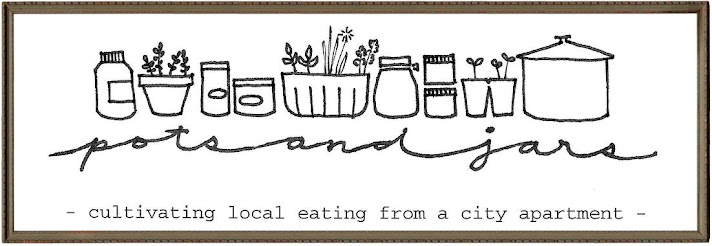
Guess who's bizzzack---??? I've been busy moving, and vacationing, and unwinding from all the moving and vacationing, that I've been ignoring my lil' P-a-J for too long.
Let's talk about GROWING FOOD already. For a blog about local food, it's about frickin' time.
Jar sprouting: me love. With some common kitchen equipment, a tiny bit of apartment space and a little time, you too can help sprouts emerge from their hard shells and enter the real world. Not only is it fascinating to watch, but sprouting seeds improves its digestability and nutritional value. So go ahead and eat your cute little sprout babies.
You can sprout many dry beans or seeds from your local bulk store (e.g. chickpeas, wheat berries, quinoa), but the yields likely won't be as high as if you used seeds specifically sold for sprouting. I usually buy Mumm's brand, since this seems to be the only brand available in Toronto. You can buy a variety of Mumm's seeds at many shops, including Toronto Sprouts, The Big Carrot and Essence Of Life.
Before you start, check to make sure the seeds can be sprouted by the jar method.
Tools:
Wide-mouthed glass jar (I usually use a 1L mason jar)
2 tbsp sprouting seeds (my favourite: daikon radish seeds... spicy like wasabi! And they grow little white root hairs that look creepy and neat)
J-cloth or cheesecloth - cut to fit over the top of the glass jar opening
Elastic band
Medium-sized bowl
Directions:
Add 2 tbsp seeds into the jar. Secure cloth onto top of jar with elastic. Rinse seeds by adding water to jar (through the cloth), and draining water. Fill jar again to cover the seeds. Let seeds soak for 2-6 hrs. Drain water, invert jar, and prop on an angle in the bowl. Twice a day, say, when you wake up and before you go to sleep, add some water to the jar, swirl, drain, invert and prop. In 3-6 days, you'll have a jar full of sprouties ripe for the eatin'.
 Home-Style Potatoes with Daikon Radish SproutsSeason: Autumn or winter
Home-Style Potatoes with Daikon Radish SproutsSeason: Autumn or winterI adapted this from The Veganomicon cookbook's "Diner Home Fries" recipe. You can change it up a bunch of ways.... add/sub chopped peppers, turmeric, cumin seeds, chili peppers. Serves 2 as a side dish.
Ingredients:
2 medium sized potatoes --- sliced into 1/2" thick pieces
1/4 onion --- chopped
a handful of fresh daikon radish sproutsoil for frying
salt and
pepperDirections:
Bring a medium-sized pot of water to boil. Add potatoes, and cook on medium heat until firm but can be pierced with a fork (10-15 mins). Drain.
Heat oil in a skillet on med-high heat. Add potatoes, arranging in a single layer in the skillet. Cook until nicely browned (7-10 mins), and stir to brown the other sides, adding oil if needed. Add onions, stir and cook for 3 mins. Add sprouts and cook 2 mins until onions are transparent. Add salt and pepper to taste.
 So now you have seeds and the basic seed starting equipment. Next step: SEED STARTING. Finally....oh joy!
So now you have seeds and the basic seed starting equipment. Next step: SEED STARTING. Finally....oh joy!





